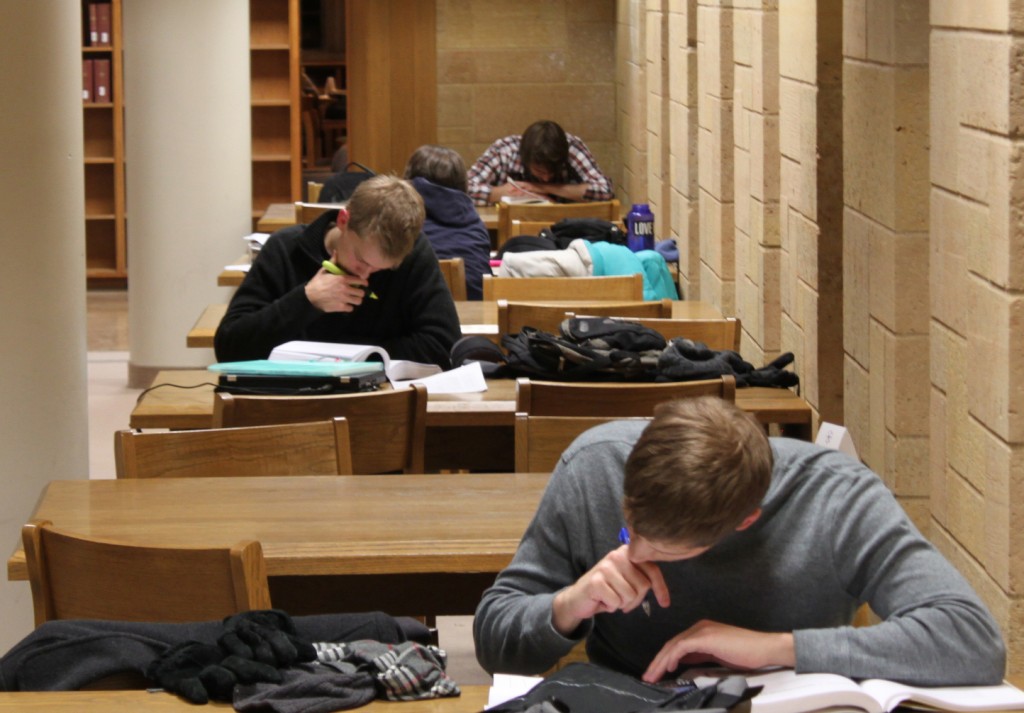In a time of increasing tuition costs, a new book has raised alarm about how much students actually are learning at college. But research shows that academic growth at St. Thomas is high.
Richard Arum and Josipa Roksa’s book, “Academically Adrift,” draws on research from the Collegiate Learning Assessment and claims America’s higher education system is failing to develop skills “widely assumed college students should master.”
“At least 45 percent of students in our sample did not demonstrate any significant improvement in Collegiate Learning Assessment performance during the first two years of college,” the book states. “Further study has indicated that 36 percent of students did not show any significant improvement over four years.”

In 2007, 176 four-year schools participated in the CLA, ranging from large universities, such as the University of Kentucky, to smaller schools, including St. Thomas, Bethel, and Macalester.
According to St. Thomas’ Institutional Research and Development, Tommie students stack up well: St. Thomas scored in the 97th percentile for academic growth of students over four years, meaning only 3 percent of schools had students showing more improvement.
Mike Cogan, director of Institutional Research and Analysis, said St. Thomas scored in the 99th percentile in the analytical writing portion of the test.
“No one’s students grew more than ours,” Cogan said.
Tommie seniors expressed the same belief. In a 2008 survey of 600 seniors, 90 percent responded “very much or quite a bit” to describe the extent their coursework at St. Thomas emphasized their ability to think critically and analytically.
History department chair Catherine Cory said St. Thomas’ strong performance can be attributed to the combination of experienced professors and smaller class sizes.
“Our courses … and class sizes are small by comparison to large research institutions,” Cory said. “Our large core curriculum is designed to teach critical thinking skills, accurate analysis of source materials and clear and careful writing skills.”
St. Thomas’ liberal arts emphasis may play a factor as well. “Academically Adrift” said students with majors in liberal arts improved significantly more than students in other fields of study.
Writing Across the Curriculum
Cogan said another testing period for the CLA is set for the spring, when St. Thomas seniors’ improvement will once again be measured. St. Thomas hopes to aid the improvement of this year’s and future classes by implementing the Writing Across the Curriculum program, which Cory said is a “comprehensive program that uses writing … to promote learning.”
“Writing Across the Curriculum will place more emphasis on the quantity and types of writing,” economics department chair Agapitos Papagapitos said.
An increase in writing requirements would go against another aspect of the research for “Academically Adrift,” which said less than half of students had taken a course the previous semester requiring 20 or more pages of writing. The study also found that about one-third of students didn’t take a course requiring 40 or more pages of reading per week.
Cory wasn’t sure counting pages was an effective measure, however.
“Forty pages of poetry, or philosophy, or theology per week would be considerable,” she said.
Papagapitos was wary of the figure as well.
“When you’re talking about a dense philosophy book … that’s a lot of pages,” Papagapitos said. “So I think you have to be careful looking at a number just plain like that.”
Papagapitos said the writing limitations of 20 pages might be more prevalent at larger schools because of the number of students each professor has to grade.
“A lot of schools have students taking classes with hundreds of other people,” he said. “That’s thousands of pages to grade, which is impossible.”
It’s up to the student
St. Thomas’ size may allow for increased requirements, but some students have made an effort to avoid the work. “Academically Adrift” says students intentionally “enroll in courses that do not require substantial reading or writing assignments.” Senior Lauren Rembowicz said that can be the case.
“You can make it really easy or really hard,” Rembowicz said. “I [made it easy] for last semester. I’m taking yoga.”
“Academically Adrift” highlights multiple other factors, including group versus solo study habits, increased time spent on non-academic activities, and an overall attitude of the college experience “as being focused more on social than on academic development.”
Senior Nick Haugan said it is up to each student to dictate what he or she gets out of school.
“St. Thomas, if you try hard, is a great school with great programs,” Haugan said. “I’ve tailored [my education] to make it as challenging as possible.”
Jordan Osterman can be reached at jrosterman@stthomas.edu.



97th and 99th percentile on overall growth? That’s awesome — and completely believable, given the first-rate education I received at UST. I just hope U.S. News & World Report never figures out what a gem we have in UST, or the tuition will go up so high I won’t be able to send my kids!